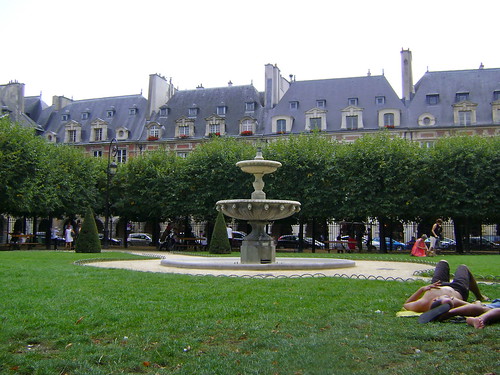Getting lost in Le Marais
Musée Carnavalet
Paris is remarkable at face value but its true character comes out only when you take time to explore each of its arrondissements.
Each arrondissement has its own personality—the young, lively, and professional crowd filling up bars in the Bastille; the artsy bohemians hanging out in cafés around Montmartre; the students and backpackers finding the best bars to spend the night in the Latin Quarter; the trendy and chic searching for fashion and glam along the rues of Saint-Germain-des-Prés—and each one can appeal to a different part of you.
You can have your very own part of Paris that suits your personality best. For me, it is Le Marais.
Le Marais, which is situated in the 3rd and 4th arrondissements, is rich in history and culture. The small, medieval streets are home to not only chic shops, but also delicious food, unique bars, and fantastic museums.
Modern shop with old sign from a boulangerie in Le Marais
Le Marais mixes all the best of Paris—old and new, young and old, traditional and modern. Men with gray, flowing beards wearing black fedoras can be seen walking down rue des Rosiers with their prayer book, right next to a happy couple entering a bar with a proudly displayed rainbow flag hanging in the window, or a young French woman wearing the newest fashion carrying several shopping bags. It is an area that has held on to the past but embraced the present.
People who know good food in Paris come to endure the long line at L’As du Falafel to enjoy a 5€ falafel. Le Marais is also the place to flock to on Sundays. While the rest of sleepy Paris is closed down for its day of rest, the streets of Le Marais are wide awake and lively. The day can be spent enjoying a café crème on a terrace, lounging in the Place des Vosges, shopping on rue Saint-Paul, exploring Paris history in the Musée Carnavalet, or meandering along the small streets woven into the neighborhood.
Place des Vosges
This is the oldest and best preserved area of Paris with a long and colorful history. Although at the height of splendor in the 17th century Le Marais was the place to be, the creation of Versailles resulted in the nobility moving away from the area, leaving Le Marais neglected and unappreciated. It quickly became a slum and Jewish ghetto that underwent severe damage during WWII.
In the 19th century, when Baron Haussmann started one of the greatest urban construction projects ever seen, Le Marais was left untouched due to his lack of interest in the area. Therefore, Paris got its grand squares and large boulevards and Le Marais was left with its small passages and ancient buildings.
However, due to the growing grandeur of Paris, the real estate in Le Marais started to become more appealing. Soon decrees were passed to protect the area and prevent demolition. With much time, the problems caused by years of neglect were rectified and Le Marais became the bustling neighborhood it is today. Much of the preserved history adds to the charm of Le Marais—modern shops found in old pâtisseries still proudly display the old signs above their doors.
Le Marais is one of the neighborhoods that brings Paris to life. Food, art, culture, and history can all be found, making it the perfect place to explore.










Ah, excellent ! I now have somewhere to go on Sundays 🙂